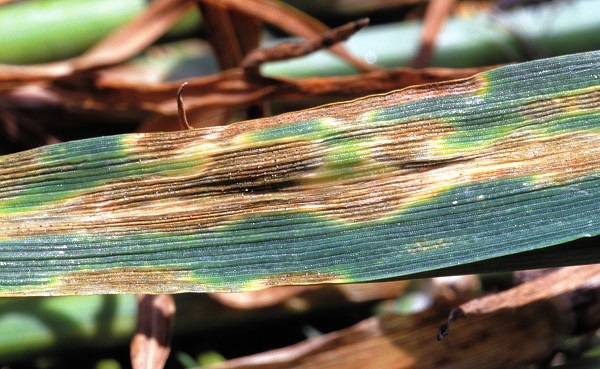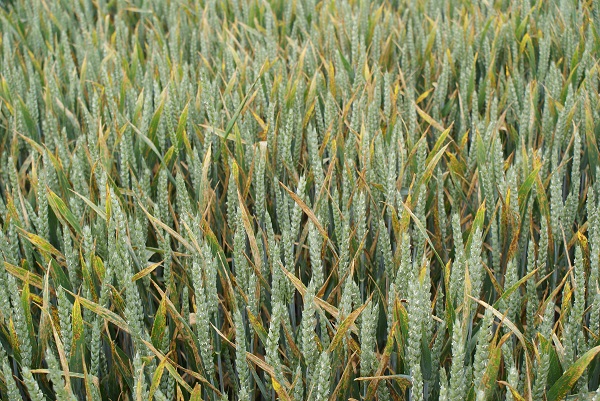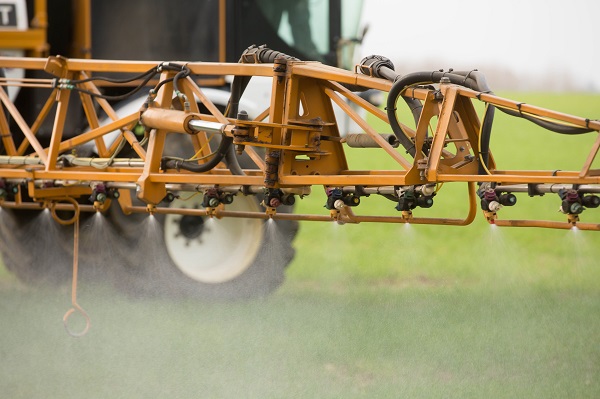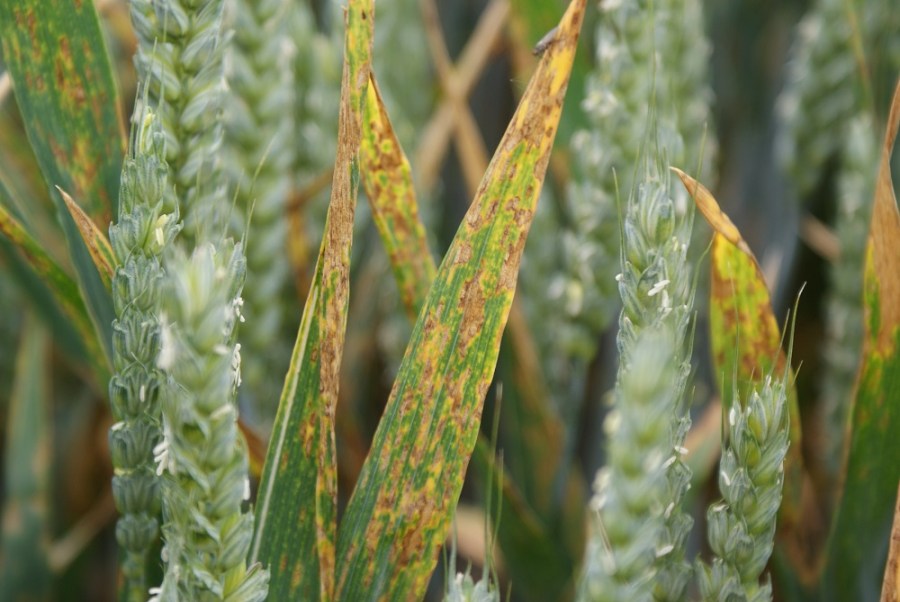Septoria is the primary target disease for the UK’s wheat growers. In this feature, Professor Fiona Burnett from SRUC explains the latest in understanding this complex and evolving disease, including an update on the latest research into fungicide resistance, epidemiology and control.
Duelling with the polymorph
Septoria continues to put up a good fight, constantly adapting to survive the onslaught of fungicides aimed to keep it in retreat. CPM finds out why septoria is proving such a worthy adversary and how to keep it on the back foot.
Resistance is Darwinian.
By Lucy de la Pasture
Septoria is a disease of global importance and was recently identified as the most yield-reducing disease in European countries with intensive wheat production, with yield losses of up to 50% reported.
Septoria is managed mainly through fungicide applications and to a lesser extent by the use of resistant varieties. Up to 18 loci associated with plant resistance have been identified and incorporated into wheat-breeding programs, providing some quantitative resistance to the disease but most varieties currently grown in the UK are only moderately rated for resistance (5’s or 6’s). Plant breeders are working on new resistance factors and varieties with better resistance are beginning to come through.
The septoria pathogen has proven adept at overcoming plant resistance and evolving fungicide resistance. Two of the three modes of action active on septoria have varying degrees of resistance, with field isolates of septoria detected with mutations conferring some insensitivity to the SDHIs in the past two seasons.
Fiona Burnett, professor in applied plant pathology at SRUC, sheds some light on the current resistance situation in the septoria population and how best to manage it.

Small black fungal bodies (pycnidia) on lesions can easily be seen by eye.
What is septoria?
Zymoseptoria tritici is the fungus responsible for causing septoria leaf blotch in wheat. The first common sign of the disease is found in the autumn and winter, where pale brown lesions on the bottom leaves with small black fungal bodies (pycnidia) can easily be seen by eye. During leaf production phases of growth in the winter and early spring, new leaves often appear green and healthy and lower leaves die back, showing these typical symptoms.
In recent years, septoria has become more difficult to control as the causal pathogen has adapted to become less sensitive or resistant to many fungicides. Currently the azoles are gradually declining in efficacy as protectants and their eradicant activity has been severely reduced. Fungicide programmes have become more reliant on the new generation SDHIs and a few mutated strains with reduced sensitivity are beginning to appear in the field, signalling the beginning of the emergence phase of resistance. These are still at low frequencies so there hasn’t been any loss of efficacy in field situations.

Anti-resistance strategies are about protecting future chemistry as well as the current portfolio.
How does it spread?
Septoria has a sexual phase in the autumn and airborne ascospores are blown in to crops, where they may infect wheat plants. This sexual phase is where a genetic reshuffle occurs and effectively sets the scene for the septoria population in the spring. It’s also the predominant driver of epidemics, though studies have recently shown there is also transfer of inoculum from trash in the field which will add to the diversity of the population.
The airborne phase can blow for long distances but the septoria isolates found within countries mostly reflects the varieties grown and the fungicides used on crops. The UK and Eire have weather conditions most conducive for septoria to thrive, so disease pressure is the highest within Europe. Consequently, the UK is at the forefront of fungicide resistance problems with higher fungicide usage.
Rain and windy conditions provide the optimum conditions for spores to be released and splash onto healthy leaves. Once a spore has landed on a new leaf, it can take 12 hours for it to germinate; infection of the new leaf usually takes place within 24 hours of the spore being released. Wet conditions are required during this infection process.
Symptoms don’t appear immediately on a new leaf. The fungus grows undetected inside the leaf for a period of 14-28 days. The speed of visible symptom development is linked to temperature so during the winter it can take a long time for symptoms to appear, while in the summer, symptoms can develop more rapidly. If the fungus is well into its latent phase, no fungicide will provide effective eradicant activity.

Reliance on controlling septoria using fungicides has created a big advantage to septoria isolates carrying fungicide resistance.
How has resistance evolved?
Resistance is Darwinian so reliance on controlling septoria using fungicides has created a big advantage to septoria isolates carrying fungicide resistance. Add in high disease pressure and poor resistance in wheat varieties, and the result is a real niche for resistant isolates.
The predominant resistance mechanism is where there’s a change of shape to the target site of the fungicide, but it’s not the only way the pathogen can evolve to get around the chemistry we’re using. Another means is upregulating, where the pathogen produces more copies of the enzyme the fungicide is targeting, reducing the fungicide’s effectiveness.
Of particular concern to pathologists is a mechanism known as the efflux pump, where the pathogen becomes more efficient at pumping toxins out of cells so potentially all fungicides are affected to a greater or lesser extent, although isolates carrying this mechanism occur at quite low frequencies in the field. It’s an energy-heavy mechanism for the pathogen which shows the degree of selection pressure we’re exerting and the increasingly complex septoria population which results.
How does this affect septoria in the UK?
The evolution of resistance has been distinct in the different fungicide groups. Azole fungicides work by binding to the target site protein, sterol 14α- demethylase (CYP51) – a key enzyme in the biosynthesis of a fungal cell membrane component. There have been multiple CYP51 mutations, which has resulted in a slow shift in sensitivity to the azoles. Isolates within the septoria population now all have multiple CYP51 mutations present.
In contrast, resistance to the QoIs (strobilurins) occurred in a single step, with 90-100% resistance appearing in the field populations within a single season. This single mutation conferred such an advantage to the resistant isolates that they were easily able to dominate.
The pattern of emergence of resistance to SDHIs will likely sit somewhere between the QoIs and azoles. To date there have been small changes to the target site protein, succinate dehydrogenase (SDH) but the low impact mutated isolates are becoming more common and for the first time some now have more than one mutation at the target site, as seen in azole resistance, so the population seems to be becoming more complex. However, the role and impact on fungicide sensitivity of these mutations is not fully clear.
What’s the effect on current chemistry?
The efficacy of azole chemistry in the UK is declining slowly as the septoria population has evolved resistance, particularly in an eradicant situation. They still provide useful control in a protectant situation and remain an essential part of fungicide strategies.
SDHI efficacy in the field remains strong but maintaining this status quo is a top priority. Because resistance is only starting to emerge, there’s an opportunity to slow this down by adopting strong anti-resistance strategies.
How do you protect the chemistry?
The number of SDHIs that can be used is limited to two applications for good reason. Both frequency of application and dose rate are drivers of selection pressure. Where azoles are concerned, the main factor fuelling resistance is the number of applications. This means that that the azole dose used in programmes can be increased to robust levels without fuelling resistance.
Designing a fungicide mixture that provides a balanced dose of its constituent products is an important means of protecting chemistry – each product, SDHI and azole and multisite, needs to be used at a dose that won’t place over reliance on its partner to provide control. In practice this means using azoles at a sensibly high dose rate.
Adding a multi-site to the mix is a key part of resistance management in the programme. They offer a ‘safe-haven’ in terms of resistance and aid control at a very low additional cost.
How many SDHIs to apply depends on the risk to the crop and the added efficacy the SDHIs provide is crucial in a high disease pressure scenario. But look for the win wins where using SDHI chemistry – such as using appropriate azole rates to balance them and the addition of multi-sites – to get the benefits they offer without exerting undue selection pressure.
What does the future hold?
Protecting chemistry isn’t just about the current armoury, it’s also about the future. There’s a new triazole in the wings offering improved efficacy but we’ll need to pull out all the stops to reduce selection pressure because septoria is adept at adapting to different triazoles. If chemistry is mis-managed then its lifespan will be reduced.
As far as the SDHIs are concerned, if the efficacy situation does deteriorate in the field then it’s possible this will be a slow erosion in activity rather than the rapid decline to zero efficacy we saw with strobilurins, but either is unwelcome.
Maintaining diversity in programmes by using actives from different fungicide groups is crucial. Using different actives within one group can help to make life more difficult for the septoria pathogen but it isn’t a strong anti-resistance measure at all. There’s likely to be loss of azoles under current legislation which means we’ll have to improve managing our crops for risk by making use of highly resistant cultivars, late drilling and balancing fungicide doses.
Don your wellies for a spot of crop walking
Take an active interest in your own agronomy, put on your boots and get out and walk your crops is the advice from Pat Thornton, an independent agronomist and farmer at Low Melwood Farm, Owston Ferry in Lincs.
Pat Thornton farms 135ha of ‘bad blackgrass’ land, which has prompted a move to more spring cropping, as well as cover crops, in his rotation of winter wheat (Cordiale, Dickens and Evolution), spring wheat (Mulika), spring barley (KWS Irina) and oilseed rape (Campus).
“Employing an agronomist shouldn’t become an excuse for not being involved in your own agronomy,” he suggests. “A lot can happen between their visits – disease explosion, weed growth and pest damage and, being on the farm on a daily basis, you’re in the best position to act, so work with your agronomist.
By reducing attention to detail, you lose the opportunity to take preventative measures and will be forced into curative action, he says.
“By this time the damage may already be done and your yields will have been compromised. With fungicides, vigilance is vital and we should all be going back to basics to take away guess work, starting with accurately identifying growth stages, as well as disease,” he adds.
“We all know the risks; rain splash causes septoria in wheat and poorly timed T-applications allow disease to take hold, yet often growers don’t always take the timely and the right action.”
A firm believer in knowledge transfer from R&D to practice, Pat has held roles with AHDB, managing Monitor Farms, NIAB-TAG and ADAS.
“A scientific understanding is easily achieved, given the wealth of free information available, and it should be fundamental to farming,” he reckons.
“Disease control is season long, but our reliance on fungicides has led us into troubled waters. Like our ongoing battles with blackgrass, now is the time to understand the fundamentals of disease control and the importance of quality investment.
“Like the tools in our toolboxes, it helps to know how the fungicides we use work –- understand which mode of action each one belongs to, and how to get the best out of it. It’s simple, back-to-basics risk management stuff, and there’s a lot of value to be gained from it.”
Fungicide choice is becoming simpler, he says. “We have less and less chemistry in our armoury, which makes it much easier to choose which fungicides you’re going to apply and always have resistance management in mind.
“Use the multi-site active chlorothalonil where you can, keep the dose rates of all fungicides high, opt for high quality products and aim for protection rather than cure.”
A self-confessed advocate of the insurance approach to cereal fungicide applications, last season Pat Thornton applied a T0 and T1.5 based around chlorothalonil, and an SDHI at T1 and T2.
“There’s some very good chemistry out there, last year I used Adexar and wasn’t disappointed. I also played around with my T2 and T3 timings to see how I could influence fusarium control. It turned out that my timings weren’t ideal, proving the point that the window of opportunity for applying an effective T3 is very, very small.”
His final point is the importance of continually trying new things and learning from them. “In-field trials, on your own farm are really valuable. I’m very hopeful that I will be selected for the BASF Real Results trials – it’s a really good initiative for demonstrating where the bang for your buck really comes from.”
Duelling with septoria: top tips.
- Assess the risk of septoria – using the appropriate amount of chemistry in the situation to counter it.
- Only apply balanced mixtures – consider the dose of each component and adjust accordingly so that they provide maximum support to their partner.
- Make good use of multi-sites – they have a low resistance risk and bolster control, taking selection pressure off the SDHIs and azoles.
Sponsor message
Adexar is the market-leading SDHI. Independent trials have consistently confirmed that Adexar is the strongest SDHI for controlling both Septoria and yellow rust, as well as offering protection against eyespot in wheat. Given the flexibility to apply at either T1 or T2, Adexar will deliver the highest return of any fungicide in a Septoria and yellow rust risk situation (can we say something along the lines of the Septoria and YR scenario is the most common in UK Crops?). With Adexar you have the widest effective spray window if you do not hit optimal timings, delivering more consistent yields under sub-optimal conditions, as well as greater on-farm flexibility. Adexar has been proven to improve nitrogen utilisation, water use efficiency and encourage deeper rooting. For use in both wheat and barley.




